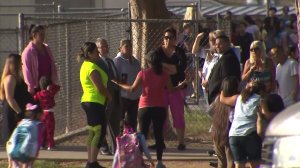Hundreds of concerned parents attended a meeting Wednesday at Jurupa Valley elementary school after two students were the subject of “unconfirmed” reports that they were diagnosed with leprosy, but some left the meeting without getting the answers they wanted.

The students’ cases were first reported by the Jurupa Unified School District in a letter sent home to parents of Indian Hills Elementary School students on Sept. 1. At the meeting school officials did not confirm the cases, citing a moral obligation to protect the privacy of students which angered some parents in attendance.
“They are just not answering any questions,” parent Isavella Engelauf said at the meeting. “It’s just not right.”
The report of the students’ diagnoses had not been confirmed by the Riverside County Department of Public Health.
“In an abundance of caution, administration wanted to share this information with you as soon as possible,” a portion of the letter read.
It wasn’t immediately clear if the school district had any further information about the students’ cases. The county’s director for disease control told the Los Angeles Times Tuesday that it will take several weeks to confirm the diagnoses.
Nursing staff at the school notified county officials about the suspected infections after a parent told staff about a preliminary diagnosis, the newspaper reported.
On Tuesday, the county’s public health department posted on its website an FAQ about leprosy, also known as Hansen’s disease. It is spread through respiratory droplets between people who are in close contact, the document states. Although it is notorious, officials say it is easily treated with antibiotics.
Leprosy is a bacterial infection that is not considered highly infectious or easily spread in group settings, and it is easily treatable with antibiotics. Symptoms may not appear until years after infection, according to the Centers for Disease Control and Prevention.
Symptoms include skin lesions and growths, severe pain or numbness, muscle weakness and paralysis, and eye problems, among other effects. Effective treatment was pioneered at the the federal government’s National Hansen’s Disease Program in Louisiana in the 1940s.
The disease is rare in the U.S. but is widespread in Brazil, India, Nepal and a number of African and Pacific Ocean island countries, according to the CDC. In 2014, the most recent year for which federal data is online, 175 new cases were reported in the U.S., with 20 of those in California.
“Evidence shows that 95% of all adults are naturally unable to get the disease, even if they’re exposed to the bacteria that causes it,” the CDC website states.




